Develop and apply a personal portfolio of Design Ideas and Options
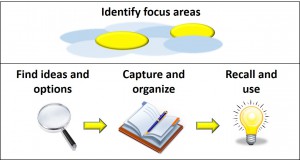
Design involves making choices from options. Where do these options come from? Sometimes they are developed on the spot, but often the essence and core of the options are drawn from our knowledge and experience – from the things we have learned or done. We all have a personal portfolio of ‘design’ options from which to make choices. For common situations, such as responding to a standard request for information or choosing a restaurant, we probably have a few favorite or default options and the choice is almost automatic. For uncommon or complex situations, such as designing your organization’s social media strategy or planning that ‘difficult’ conversation with a co-worker, there is a range of interrelated choices and associated options that are often not obvious. Our portfolio of design options for such situations may be less clear and distinct, but does exist, otherwise we could not make progress.
If our portfolio of options is limited, so is the range of responses we can make. For complex and uncertain situations, this reduces the chances that we will find a good fit between our response (choices) and the needs of the situation. Increasing the choices available to us in a situation also improves our confidence that we will be able to deal with the situation and reduces stress and anxiety. This is particularly so for situations that uncertain, poorly structured and/or complex.
Our portfolio of personal design options need not be explicit. It may exist in the form of accumulated and validated knowledge and expertise that we have developed from our education and experience over the years. However, the increasing pace of complex change means that, for many of us, we often encounter situations where the way forward is not clear or obvious. In these cases, we will benefit from being able to develop, draw on and assess even more options. How do we do this?
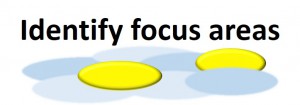 |
First, we need to develop and understand the focus or theme for our portfolio of options. For professional designers, the development of a focus is relatively natural and straightforward. It is likely to be defined by a combination of factors such as method, functionality and aesthetic, and be developed as part of their early professional education and experience. For those of us that have more of an analytical background and don’t think of ourselves as ‘designers’, identifying the focus of our personal design portfolio(s) may not be at all obvious. It requires thought and effort.
We can get pointers to the focuses for our design options by considering the following questions:
In addition to subject matter specific areas, there are several generic areas where most managers and professionals would benefit from developing a portfolio of design choices so that each instance is customized and optimized. These include:
|
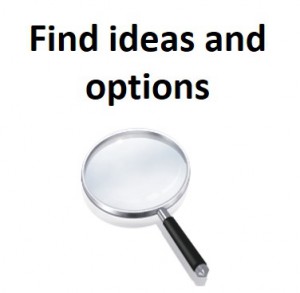 |
An important first step in adding to our portfolio of options is to be aware that we are looking. Some new options will be identified when we are consciously looking for them, such as when we attend a professional development event, but we will also come across new options during our normal activities.
As a general rule, we tend to find new design options, or ideas for new options, when we spend time at or near the boundaries of our usual experiences or interests. At the boundaries we are exposed to things that are different and unusual, but not so different and unusual that we cannot relate to them. At the boundaries we can find ideas and experiences that are ‘similar but different’. Some people call these the ‘adjacent possible’. There are various ways we can spend time at or near our boundaries. We can broaden the scope of our reading and social media exposure. We can attend conference sessions and seminars that are more on the periphery of our professional role or interests. We can consciously expand our network of contacts to include adjacent professions, disciplines and functions. We can invite on to our project teams and into our project meetings people who we know will have a different, and possibly unusual, perspective. We can track interesting technological developments before they are commercially available. In the words of Pablo Picasso, “good artists copy, great artists steal”. To see the new options, we need to have a ‘prepared mind’. We need to be curious. We need to be open to new thoughts and perspectives. We need to look beyond the specific instance or example and examine the underlying concept or principle and see how it relates our context. Henry Ford got the idea for the production line from a visit to an abattoir where he saw meat carcasses moving on a chain while the workers stood in one place. We need to have a clear sense of what we are looking for – of what we mean by ‘similar’. |
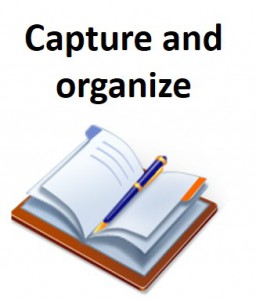 |
Thomas Edison was possibly one of the most prolific options creators of all time with 1093 US patents to his name. Edison was also a prolific note taker through which he captured his experimental work and his ideas. His notes not only supported patent applications, but also served as an aid to his memory and a record of ‘what works’ and ‘what doesn’t’. They documented the options that he and his team had pursued and described when they were successful and when they were not. An important aspect of the Edison’s notes was that they described sufficient context for each experiment so that their relevance for a future idea or experiment could be readily and confidently assessed. Edison was constrained by the ink and paper technology of his time. If we are serious about building a portfolio of design options, we need to consider our note taking strategy and whether we are taking enough advantage of the available technology.
The rich context for a new design option can often be captured as a story. Stories go beyond the clinical facts of a situation and usually include the broad sequence of events, the motivations and the key elements of the context. Stories also activate more parts of the human brain and therefore tend to be more engaging and memorable. Design options become more powerful and useful the more they are generalized. This can be achieved by categorizing specific examples and options into groupings or classes, or by identifying any underlying concepts or principles. For example, I can observe that I find new design options when I go to particular types of conferences and from a particular social media stream and can resolve to be exposed to those specific types of conferences or social media streams. Alternatively, I can recognize that the conferences and social media streams fit into the general ‘similar but different’ category and can resolve to expose myself to more ‘similar but different’ content and situations in general irrespective of the type. |
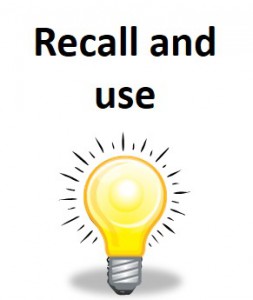 |
Garr Reynolds in his Presentation Zen blog, tells us that ledgendary filmmaker, Akira Kurosawa, said in his autobiography,
“My own experiences and the various things I have read remain in my memory and become the basis upon which I create something new. I couldn’t do it out of nothing. For this reason, since the time I was a young man I have always kept a notebook handy when I read a book…. I have stacks and stacks of these notebooks, and when I go off to write a script, these are what I read. Somewhere they always provide me with a point of breakthrough.”
Kurosawa recognizes that the creative process relies on the ideas and perspectives (options) that he has developed and experienced over a lifetime. Kurosawa also highlights the role of capture and recall in using those options to create “breakthrough”. We can use either a targeted or a broad-brush approach when recalling and using design options. The targeted approach has the advantage of being quick and efficient, especially if the options are readily searchable and well tagged. The targeted approach is particularly powerful if we have included the underlying concepts and principles as a basis for their tagging and cataloging. This will enable us to uncover related examples and instances and so is more likely to simulate creative and lateral perspectives and ideas. The broad-brush approach is likely to be slower and less efficient but is more likely to identify a broader suite of options and to synthesize creative and innovative linkages between those options. The broad-brush approach also has the side benefit of reminding us of the detail and extent of the design options we have captured and therefore aids memory based recall and synthesis in the future. |





Follow Us!